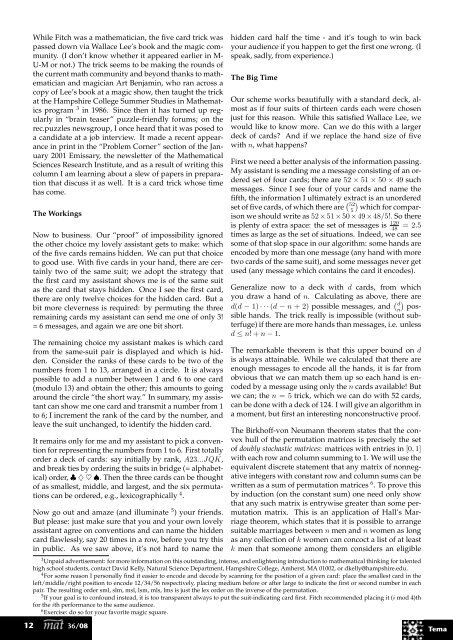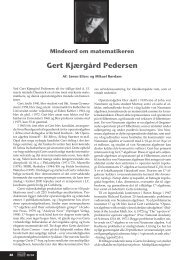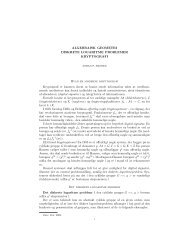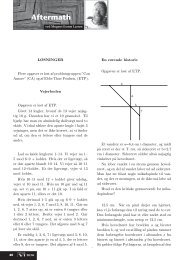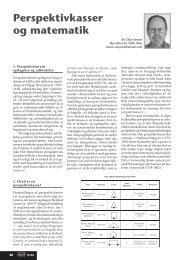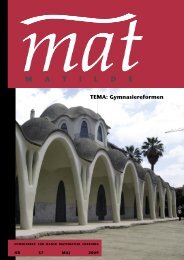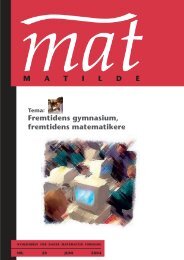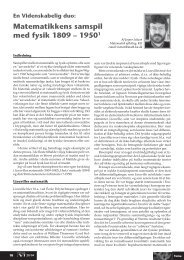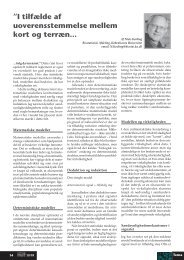Tema: Rekreativ matematik - Matilde - Dansk Matematisk Forening
Tema: Rekreativ matematik - Matilde - Dansk Matematisk Forening
Tema: Rekreativ matematik - Matilde - Dansk Matematisk Forening
You also want an ePaper? Increase the reach of your titles
YUMPU automatically turns print PDFs into web optimized ePapers that Google loves.
While Fitch was a mathematician, the five card trick was<br />
passed down via Wallace Lee’s book and the magic community.<br />
(I don’t know whether it appeared earlier in M-<br />
U-M or not.) The trick seems to be making the rounds of<br />
the current math community and beyond thanks to mathematician<br />
and magician Art Benjamin, who ran across a<br />
copy of Lee’s book at a magic show, then taught the trick<br />
at the Hampshire College Summer Studies in Mathematics<br />
program 3 in 1986. Since then it has turned up regularly<br />
in “brain teaser” puzzle-friendly forums; on the<br />
rec.puzzles newsgroup, I once heard that it was posed to<br />
a candidate at a job interview. It made a recent appearance<br />
in print in the “Problem Corner” section of the January<br />
2001 Emissary, the newsletter of the Mathematical<br />
Sciences Research Institute, and as a result of writing this<br />
column I am learning about a slew of papers in preparation<br />
that discuss it as well. It is a card trick whose time<br />
has come.<br />
The Workings<br />
Now to business. Our “proof” of impossibility ignored<br />
the other choice my lovely assistant gets to make: which<br />
of the five cards remains hidden. We can put that choice<br />
to good use. With five cards in your hand, there are certainly<br />
two of the same suit; we adopt the strategy that<br />
the first card my assistant shows me is of the same suit<br />
as the card that stays hidden. Once I see the first card,<br />
there are only twelve choices for the hidden card. But a<br />
bit more cleverness is required: by permuting the three<br />
remaining cards my assistant can send me one of only 3!<br />
= 6 messages, and again we are one bit short.<br />
The remaining choice my assistant makes is which card<br />
from the same-suit pair is displayed and which is hidden.<br />
Consider the ranks of these cards to be two of the<br />
numbers from 1 to 13, arranged in a circle. It is always<br />
possible to add a number between 1 and 6 to one card<br />
(modulo 13) and obtain the other; this amounts to going<br />
around the circle “the short way.” In summary, my assistant<br />
can show me one card and transmit a number from 1<br />
to 6; I increment the rank of the card by the number, and<br />
leave the suit unchanged, to identify the hidden card.<br />
It remains only for me and my assistant to pick a convention<br />
for representing the numbers from 1 to 6. First totally<br />
order a deck of cards: say initially by rank, A23...JQK,<br />
and break ties by ordering the suits in bridge (= alphabetical)<br />
order, ♣ ♦ ♥ ♠. Then the three cards can be thought<br />
of as smallest, middle, and largest, and the six permutations<br />
can be ordered, e.g., lexicographically 4 .<br />
Now go out and amaze (and illuminate 5 ) your friends.<br />
But please: just make sure that you and your own lovely<br />
assistant agree on conventions and can name the hidden<br />
card flawlessly, say 20 times in a row, before you try this<br />
in public. As we saw above, it’s not hard to name the<br />
12 36/08<br />
hidden card half the time - and it’s tough to win back<br />
your audience if you happen to get the first one wrong. (I<br />
speak, sadly, from experience.)<br />
The Big Time<br />
Our scheme works beautifully with a standard deck, almost<br />
as if four suits of thirteen cards each were chosen<br />
just for this reason. While this satisfied Wallace Lee, we<br />
would like to know more. Can we do this with a larger<br />
deck of cards? And if we replace the hand size of five<br />
with n, what happens?<br />
First we need a better analysis of the information passing.<br />
My assistant is sending me a message consisting of an ordered<br />
set of four cards; there are 52 × 51 × 50 × 49 such<br />
messages. Since I see four of your cards and name the<br />
fifth, the information I ultimately extract is an unordered<br />
set of five cards, of which there are � � 52<br />
5 which for comparison<br />
we should write as 52 × 51 × 50 × 49 × 48/5!. So there<br />
is plenty of extra space: the set of messages is 120<br />
48<br />
= 2.5<br />
times as large as the set of situations. Indeed, we can see<br />
some of that slop space in our algorithm: some hands are<br />
encoded by more than one message (any hand with more<br />
two cards of the same suit), and some messages never get<br />
used (any message which contains the card it encodes).<br />
Generalize now to a deck with d cards, from which<br />
you draw a hand of n. Calculating as above, there are<br />
d(d − 1) · · · (d − n + 2) possible messages, and � � d<br />
n possible<br />
hands. The trick really is impossible (without subterfuge)<br />
if there are more hands than messages, i.e. unless<br />
d ≤ n! + n − 1.<br />
The remarkable theorem is that this upper bound on d<br />
is always attainable. While we calculated that there are<br />
enough messages to encode all the hands, it is far from<br />
obvious that we can match them up so each hand is encoded<br />
by a message using only the n cards available! But<br />
we can; the n = 5 trick, which we can do with 52 cards,<br />
can be done with a deck of 124. I will give an algorithm in<br />
a moment, but first an interesting nonconstructive proof.<br />
The Birkhoff-von Neumann theorem states that the convex<br />
hull of the permutation matrices is precisely the set<br />
of doubly stochastic matrices: matrices with entries in [0, 1]<br />
with each row and column summing to 1. We will use the<br />
equivalent discrete statement that any matrix of nonnegative<br />
integers with constant row and column sums can be<br />
written as a sum of permutation matrices 6 . To prove this<br />
by induction (on the constant sum) one need only show<br />
that any such matrix is entrywise greater than some permutation<br />
matrix. This is an application of Hall’s Marriage<br />
theorem, which states that it is possible to arrange<br />
suitable marriages between n men and n women as long<br />
as any collection of k women can concoct a list of at least<br />
k men that someone among them considers an eligible<br />
3 Unpaid advertisement: for more information on this outstanding, intense, and enlightening introduction to mathematical thinking for talented<br />
high school students, contact David Kelly, Natural Science Department, Hampshire College, Amherst, MA 01002, or dkelly@hampshire.edu.<br />
4 For some reason I personally find it easier to encode and decode by scanning for the position of a given card: place the smallest card in the<br />
left/middle/right position to encode 12/34/56 respectively, placing medium before or after large to indicate the first or second number in each<br />
pair. The resulting order sml, slm, msl, lsm, mls, lms is just the lex order on the inverse of the permutation.<br />
5 If your goal is to confound instead, it is too transparent always to put the suit-indicating card first. Fitch recommended placing it (i mod 4)th<br />
for the ith performance to the same audience.<br />
6 Exercise: do so for your favorite magic square.<br />
<strong>Tema</strong>


